2008 VOLKSWAGEN JETTA warning
[x] Cancel search: warningPage 248 of 477
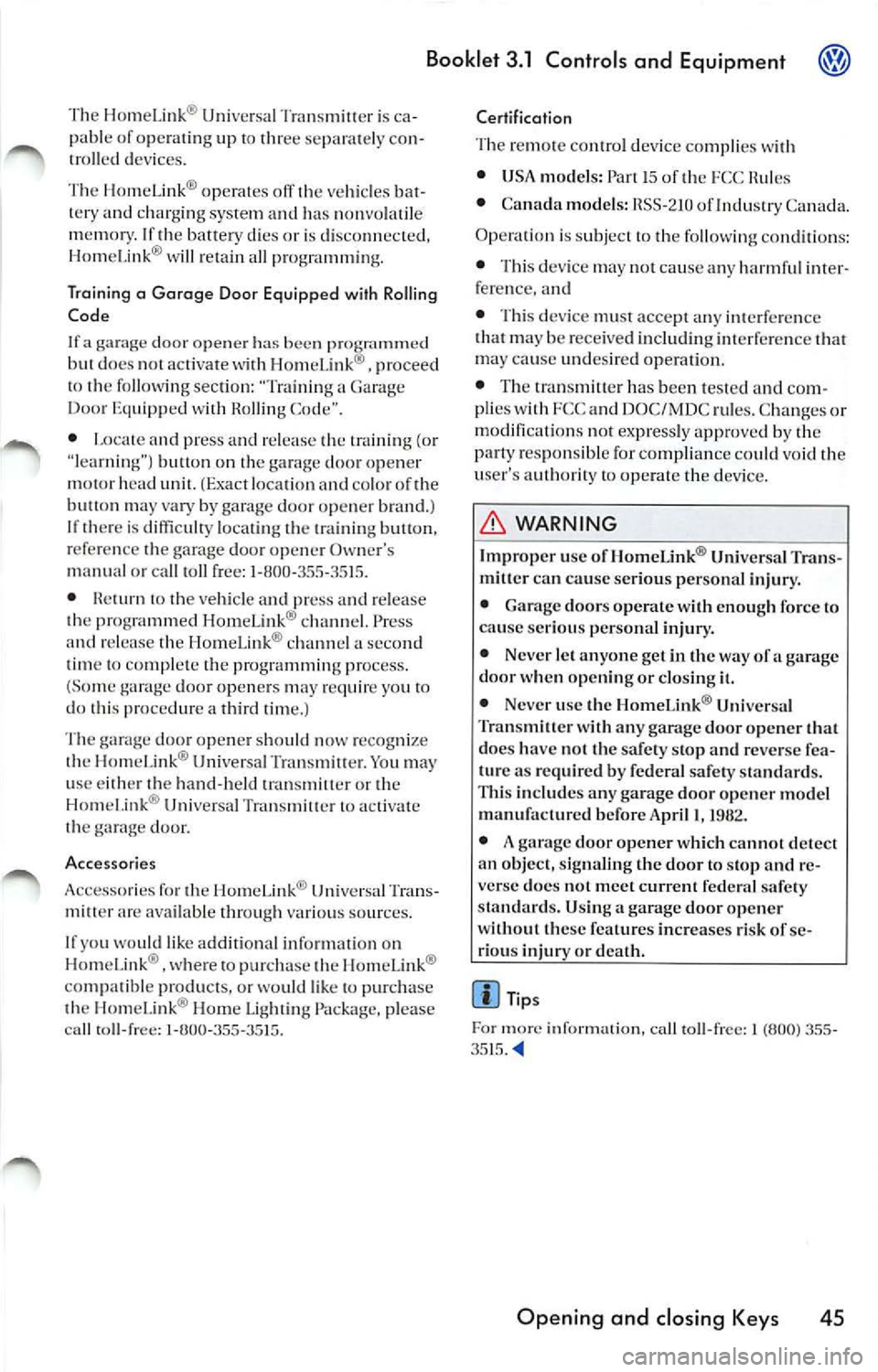
Booklet 3.1 Controls and Equipment
The Homelink ® Universal Tran smill cr is ca
pab le of opera tin g up thr ee se para te ly co n
tro lled dev ices.
Th e HomeLink ® op era tes off
vehicl es bat
t e ry and ch arg ing system and has non volat ile
m em ory . If th e batt ery dies or i s di sco nnecte d ,
l-lom eLink ® will re tain all programmin g.
Trai ning a Garage Door Equipped with Rolling
Cod e
I f a
d oor opene r has bee n progra mmed
b u t doe s not activa te w ith H ome Link®, proc eed
the fo llowin g section: "Training Ga rag e
D oo r Eq uipp ed with Rolling
• and pre ss and r eleas e train ing (o r bu li on on garage door op en er
m otor h ead unit. (Exa ct loca tion and colo r of th e
bu tto n ma y vary by garage door opener bran d.)
I f th ere is difficulty locat ing th e tra in ing bull on,
refe re n ce th e garage doo r opene r O wn er's
manu al o r ca ll toll free:
1-8 00-355-35 15.
• th e veh icle and a nd r elease progra mmed H am el.ink ® ch an nel. Pr ess
a nd release the l-lomeLink ® ch ann el second
t im e comp le te t he prog ram ming pro cess.
(So me ga rage doo r op en ers m ay re quir e you to
d o thi s pro ced ure
third tim e.)
T he garage door ope ner shou ld n ow recog nize
the l-lom eLink ® Univer sal
You may
u se eith er th e ha nd -h eld tran smitt er or the
Homel.ink ® Uni versa l Tran smit te r
to ac tivate ga rag e door.
Acc essor ies
A ccesso ries fo r th e Hom eLi nk ® Un ive rsal Tran s
mill er are ava ilab le thr ough variou s sources.
If yo u wou ld like additi ona l inf orm ati on on
Hom el.ink ®. wh ere to purcha se th e Hom e Lin k®
co mpa tibl e prod ucts, or wo uld like
to p ur cha se
th e 1-lome Link® Hom e Lightin g Packa ge. ple as e
ca ll to ll-free : l-000-355-3515. Certification
Th e re mote contro l d evice complie s w ith
•
model s: Pan 15 of the FCC Rules
• Canad a model s: HS S-2 10 of Indu str y Ca nada.
Opera tion is subj ect
the fo llow ing co nd itions:
• Thi s de vice ma y not ca use an y harm ful int er
f ere nce, and
• Thi s dev ice mu st a ccep t any in te rfe re n ce
tha t ma y be rece ive d includ in g int erfe re n ce
ma y ca use und esire d op erat ion.
• The tra nsmitt er has been tes te d and co m
pli es with FCC and DOC/MDC ru les. C hanges or
m odifi catio ns no t ex pres sly appro ved by th e
res ponsib le for comp lian ce could void the
user 's authori ty to operate the dev ice.
WARNING
Imp roper use of HomeLink ® Univer sal Tr ans
mitter can cause serious person al in jur y.
• Garage doors o perate with enough force to
ca use ser ious perso nal inj ury.
• Neve r le t anyo ne get in th e way of a garage
door when o penin g or closing it.
• Never use th e Ham el.ink® Uni vers al
Tran sm itt er w ith any garage door opener that
do es have not t he sa fety stop and reverse fea
t ure as required by fe d eral safety standards.
T hi s includ es any garage door opener model
manufactur ed befo re Ap ril
I, 1982.
• A garage door o pener wh ic h ca nn ot detec t
a n obj ec t, sig nalin g the door to stop and re
verse docs no t me et c urr ent federa l sa fe ty
standards. Usin g a garage door opener
wit hout the se feat ures inc reases risk of se
rious injury or d ea th.
Tips
F o r m ore informati on, call to ll-free : I (000 ) 355-
35 15 .
Op ening and closing Keys 45
Page 250 of 477

Booklet 3.1 Controls and Equipment @
WARNING
Cras hes a nd oth er acci dcn t s ca n hap pen w hen
yo u cann ot sec the road a head a nd when yo u
ca nn ot b e see n by other m otor is ts.
• Never use day time runn ing ligh ts to sec
w here yo u are goi ng. Th ey a rc no t b right
eno ugh an d w ill n ot let y ou sec fa r eno ugh
a h ea d for safety especia lly a l dusk or w hen it i s
dark. Always sw itch on the low bea m at du sk
or w hen it is dark .
•
t a il li ght s do not ligh t u p w hen da y
tim e runnin g lig ht s arc o n. A ve hicle w ithout
r ear ta il li gh ts turne d on ca nn ot b e see n by
ot hers in b ad wea the r at dusk o r w hen it s d ark .
Applies to ve hicles: with Highline instrument clus ter
WARN ING (continued)
• If aut oma tic head light cont rol is sw itch ed
o n, th e low bea m and w ill n ot be
switc hed on in fog or heavy You have to
sw itc h on t he low bea m using t he light sw itch .
• J\lways tu rn on th e he adli ght s befo re d usk
a n d in ra in or fo g so th at yo u ca n see a head
and so that oth ers can see your vehicl e from
t h e bac k.
Tip s
I f yo u re m ove the key from t he ig n ition lock w ith
t he ligh ls s till on, a b uzze r w iU sou nd when you
o pen
dri ver's door re mi nd yo u turn light s off .
• Always observe loca l o rdin an ces a nd traffi c
regu la tion s w hen using yo ur lights. •
Coming /leaving home function (orientation lighting)
T he comi ng hom e/ leav ing home functio n is ro lled by ligh t sensor.
Coming h om e function
If th e hea dlight s sw itc h
46, is in th e
"Au to ma tic headligh t co ntrol" (AUTO or po
sition whe n the ig n it ion is sw itc hed off an d th e
driver's door is opened and closed,
co ming
h o m e fun ction (sw itc h-off delay) switch es on
th e orientat ion ligh ti n g. The le ngth of
sw itch-o ff delay ca n be adju sted, o r sw itch ed off
co mple te ly, in Lights a nd vis io n 17.
L e a vi ng h om e fu ncl ion
th e ve hicl e is un locked, the leav ing hom e
func tion switch es on orie nt atio n li gh tin g. The lig
htin g is switched off as soo n as t he ign i
t ion is s witched on.
Tips
I f th e co min g home or le aving hom e fu nct ion is
sw itched on, the head ligh ts, s ide mar ke r ligh t,
t ai lli g h t a nd lice nse pla te ligh ts w ill come on.
• If yo u r em ove t he ignitio n key and open t he
dr iver door while the vehicle ligh ts are on , you
w ill not h ear an acoust ic warning if the comi ng
home funct io n is sw itched on.
• You can set th e com ing hom e fu ncti on
s wit ch off delay in th e Lights and vis io n
menu , provid ed yo ur ve hicl e has th is m en u in t he
di spla y.•
Lights and a clear view 47
Page 252 of 477

Booklet 3.1 Controls and Equipment
em erg ency flasher also works when th e ign ition
i s sw itched off .
L'.D, WARNING
A vehicle stalled or stopped on or bes ide a
highway can be st ruck by ot her vehicl es and
increase the risk of se rious per sonal injury.
• Whenever s tall ed or stopp ed fo r repair ,
move th e ve hicl e a safe distan ce off the road,
s top the engine, and turn of the emergency
WARNING (continued)
flash er and use a warning tria ngle or similar
d ev ice to warn approa ching
• Never park the vehicle in areas w here the
h ot cata ly tic con verter and exhaust system
ca n come in contac t w ith dry grass, brush, fu el
s pill or oth er mater ia l that can ca use fire.
Tips
Yo u can disc harge the ve hicle batt ery if yo u le ave
t h e eme rgency flash er on for a Jo ng time
Turn and high beam lever
The tum signal and high beam lever also operates the headli ght flashe,:
F ig. 27 Turn signal and high beam lever
The turn sig nal a nd high b eam lever has
rhe follo win g fun ctions:
Using the turn signals
-Mo ve the leve r a ll th e way up 27
to indicate a right turn, and all th e way
down
t o in di cat e a left turn .
Changing lane s
-Push the lever up or down to the point
w here yo u ca n start to feel res is tan ce. The
t u rn sig nal fla sh es as lon g as yo u hold the
l ever in thi s po sit ion.
Switching the h igh beam on and off
- Turn the light sw itch to
- Press th e lever fo rwa rd to po sit io n to
sw itch on the high beam s.
- Pull th e le ver back toward you to swit ch
th e hig h b eam off again.
Headlight flasher
- Pull th e lev er tow ard t he s tee rin g w hee l
to operate the
L'.D, WARNING
I mp roper use of the hea dlight fla sh er or the
hi gh b eams ca n di strac t oth er dri vers ca usin g
a cras h and serio us personal injury.
• Never use the head light flash er and high
bea ms w hen the y w ill bl ind or di stra ct ot her
m otor is ts .
• Always use the turn sig nals when chan gin g
l a n es to al ert ot her motori sts.
Tips
• The signa ls o nl y work w hen the ign ition
i s swi tched on. The co rrespo nding warnin g light
fla sh es in th e in strum ent clust er.
• The
then
co me s on in th e in strum ent clust er.
• The
flasher co mes on for as lon g as
yo u pu ll th e leve r- eve n if no oth er light s are
s w itch ed on. The warning lig ht
th en comes
o n in the instrum ent cluste r.
Light s and a clear view 49
Page 256 of 477
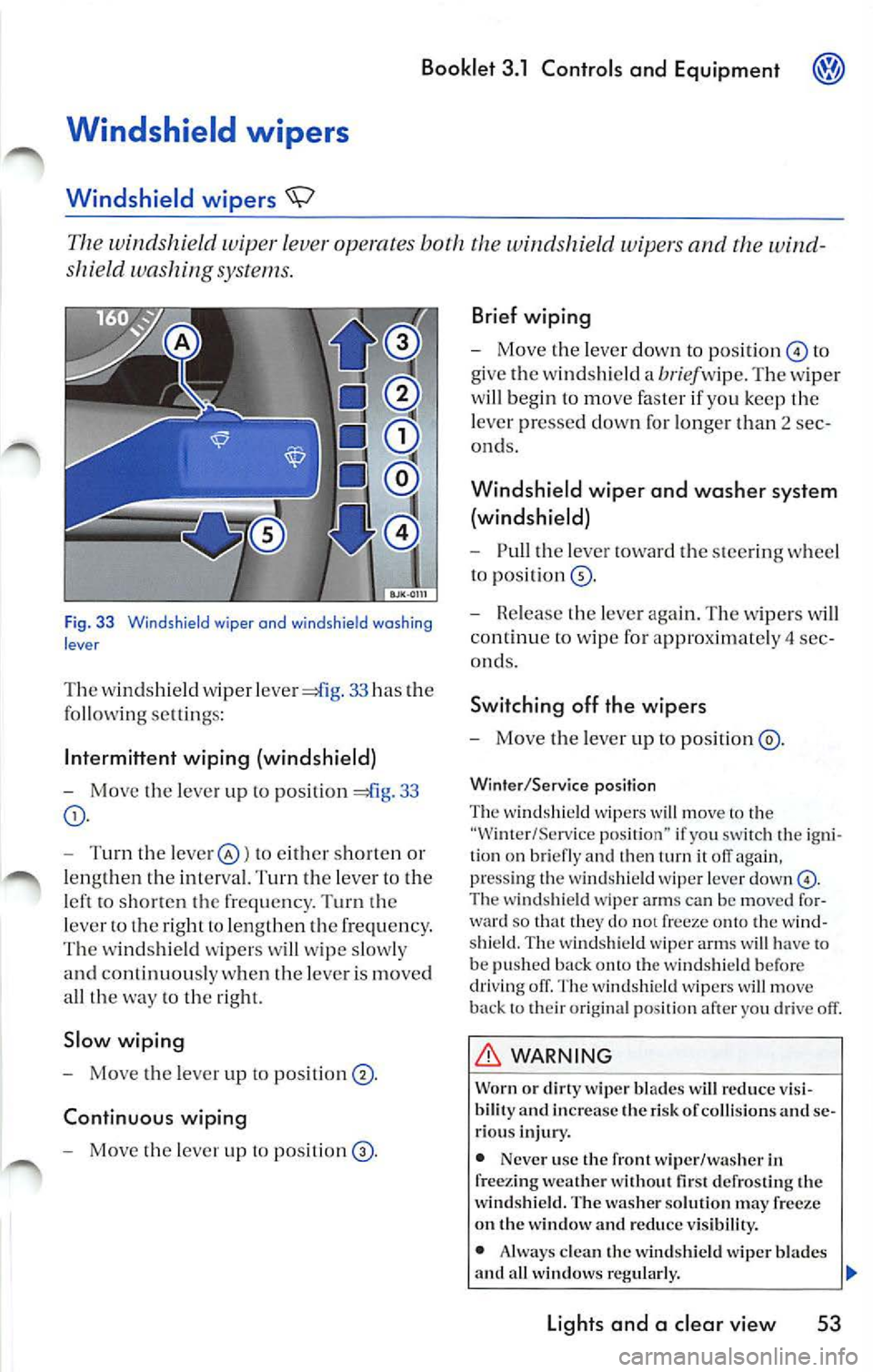
Booklet 3.1 Controls and Equipment @j)
Windshield wipers
Windshield wiper s
s hi eld washin g syste ms.
Fig. 33 Windshie ld wiper and wind sh ield washing
lever
T he w in dshield wiper 33 has the
fo llow ing se ltin gs:
Int ermi ttent wiping (windshield)
-Move t he lever up to positi on 33
- Turn th e leve r@ ) to e ither sh or te n or
l e ng th en the int erva l. Turn th e leve r to t he
l e ft t o sh o rt en the freq uen cy . T urn th e
l eve r ro th e right to le n gth en th e frequ en cy .
Th e w inds hield wip er s w ill wip e slo w ly
a nd continuou sly w hen th e leve r is m oved
a ll th e w ay
to th e rig ht.
Slow wiping
- Move the lever up to positi on ® ·
Continuous wiping
- Move the leve r up t o po siti on
Brief wiping
- Move the leve r down to position © to
give t he wind shi eld a
bri ef w ip e. T he w ip er
w ill be gin t o m ove faste r if you ke ep th e
l eve r pr esse d down for lo nge r th an 2 sec
ond s.
Windshield wiper and washer system
(windshield)
- Pull the lever towa rd the steerin g w heel
t o pos ition®·
- Rele ase the leve r ag ain. Th e wipers w ill
co ntinu e to w ipe for approx imate ly 4 sec
ond s.
Switching off the wipers
- Mo ve th e leve r up to po sition ®·
Winter /Service position
Th e wind shi eld wip ers will move to the
"Wi nter/Serv ice pos ition" if yo u sw itch th e ig ni
ti on on br iefly and th en
T he wi ndshi eld wipe r arm s can be moved fo r
w ard so that they do not freeze o nto the w ind
s hi eld. Th e wi nds hie ld wip er arms w ill have to
be pus hed b ack
the w indsh ie ld befo re
dri vin g o ff. T he w in d shi eld w ipe rs w ill m ove
b ack to th eir or ig ina l posit io n af ter yo u drive off.
WARNING
Worn or dirty wip er bl ad es w ill reduc e vis i
bilit y and incre ase the risk or co llis ion s and se
ri ous inju ry.
• Nev er u se the front wip er /wa sher in
fr ee zin g w eather without
defro stin g the
w indshield . The wa sh er solut io n ma y
on t he w indow and reduc e vis ibilit y.
• Alw ays clea n the win dshi eld wip er bl ades
and a ll w in dow s regularly.
Light s and a clear view 53
Page 259 of 477

Booklet 3.1 Controls and Equipment
Applies to vehicles : wi th power ou tside mirrors
Outside mirrors
It is impor tant for saf e dri ving to prop erly adju st th e ou tsid e ,ni rrors using joy
s tic k in
drive r's door.
Fi g. 36 Se ct io n of dr iver 's door : joy sti ck fo r th e out
s ide m irr ors
Basic setting for the outside mirrors
I. Turn the joyst ic k 36 to L (left out
s id e mirror ).
2. Mov e th e joys tick
to ad ju st th e mirror
s o that you ha ve a good view
to the re ar of
th e ve hicle. lf sy nchroni zed mirror setting
i s act ive in th e conv en ie n ce setup, the
r igh t mirro r is adj uste d at the sam e tim e
17.
3. Turn the jo ystick to R (right out sid e
mirror ).
4. Turn the jo yst ick to adju st th e mirror so
that you have a good view to the rea r o f th e
ve hicl e.
56 Lights and a clear view Outside mirror heating
-
Turn the jo yst ick to Qiµ , to heat th e ou t
s id e mirrors.
- Turn the joys tic k to 0 , to swi tch
th e
o ut sid e mirror h eati ng.
It is imp ortant for safe driving yo u have a
goo d to th e rear.
WARNING
ln corr cctlyc stim atin gdi stan ccs with the right
o ut sid e mirror can ca use co llision s and se
riou s inju ry.
• The right outsid e mi rror has a co nvex
(c urv ed) surfac e. Ve hicle s or other obje cts
see n in a co nvex mirror
will look smaller and
farth er away t.han th ey rea lly are .
• If yo u u se the r igh t o ut side mirror to judg e
di stance s from vehicl es behind you when
c h an gin g lanes, yo u could estim ate in cor
rec t.ly and cau se a cras h.
• Whene ver po ssibl e, use the inside mirror
t o mor e accurat ely jud ge dist ance a nd siz e of
ve hicl es or other objects see n in th e co nvex
mirror.
For the sak e of environment
Th e ex te ri or mirror hea ting sh ou ld be s witc hed
off whe n it is no lo ng er nee ded oth erwi se yo u
was te fu el.
Tips
If th e e lect rica l adj ust m ent of th e mi rror doesn't
r es pond, adju st t he mirror b y hand by p ushin g
li ghtly on the edg e of the mirro r
Page 260 of 477
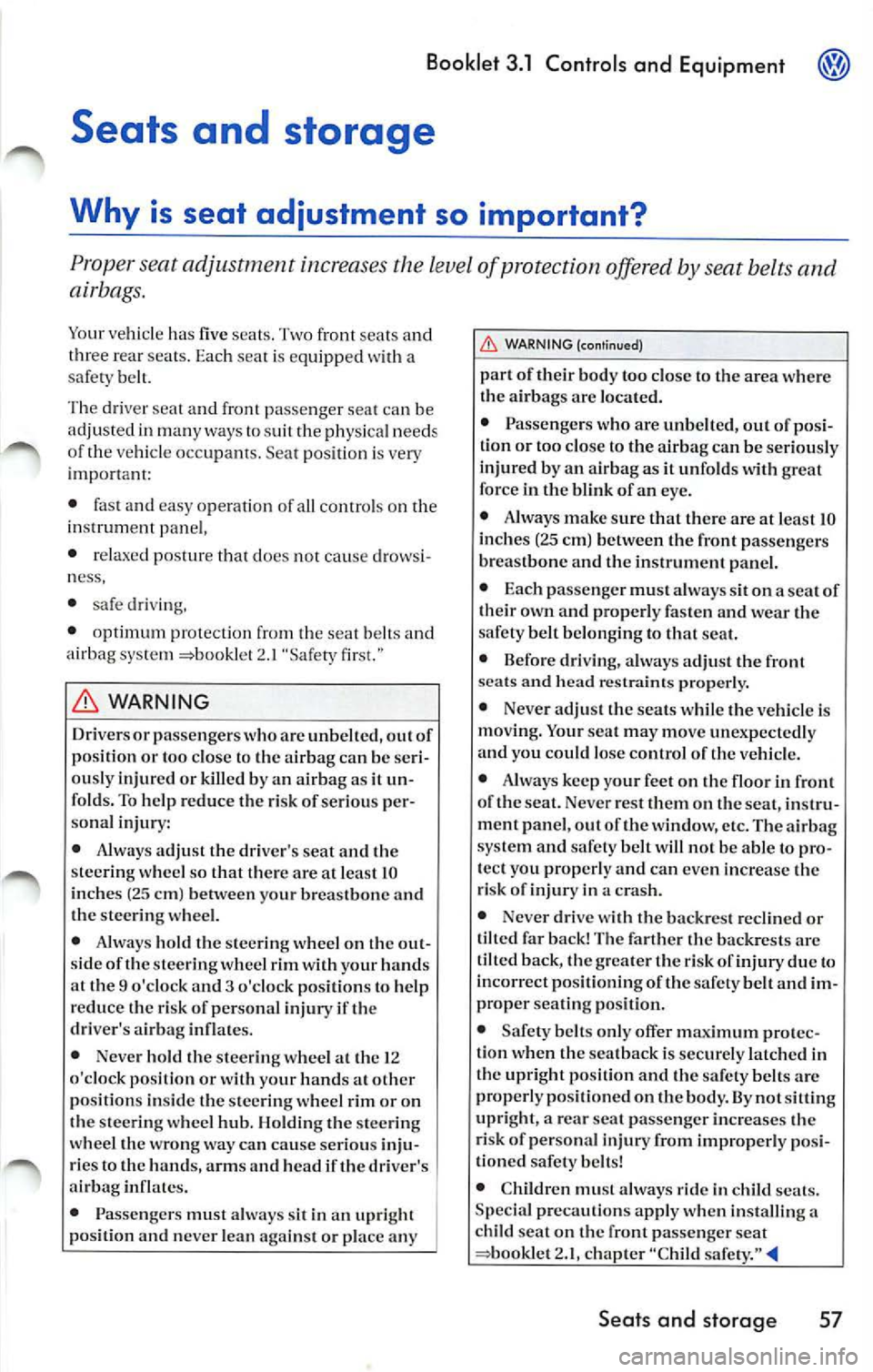
Booklet 3.1 Controls and Equipment
a
safety belt.
Th e dri ver sea t and front pa ssenger seat can be
adjusted in many ways to sui t the physi cal need s
of the ve hicle occupams . Seat position i s very
i mporta nt:
• fast and easy operation of all control s on th e
in strum ent panel,
• relax ed posture that does not ca use drow si
ness,
• safe driving,
• opt imum protection from the seat belts and
airbag syste m
2.1 "Safety fir st."
WARNING
Drivers or passe ngers who arc unbelted , out of
position or too close to the airbag can be seri
ously injured or killed by an airba g as it un
folds. To help reduce the risk of ser iou s per
so nal injur y:
• Alwa ys adjust the driver's seat and the
s teering wheel so that th ere a re at least 10
inches (25 cm) betwe en yo ur breastbone and
the steeri ng w heel.
• Alwa ys hold th e steer ing wheel on th e out
s id e of the s teer ing wheel rim with your hand s
at the 9 o'clock and 3 o'clock positions to help
reduce the risk of personal injury if the
driver 's airbag inflates.
• Neve r hold th e steer ing wheel at the 12
o'clock position or with your hands at other
pos ition s in sid e the steer ing w hee l rim or on
the steer ing wheel hub. Holding the ste ering
w hee l th e wrong way can cause serio us inju
ries to the h ands, ar ms and head if the driver's
airbag inflates.
• P assengers must alway s sit in an upright
po sitio n and ne ver lean against or place any ,0.
WARNING
(continued)
part of th eir body too close to the area where
the airbags arc located.
• Passengers who are unbelt ed, out of posi
tion or too close to the airbag can be seriously
injured by an
as it unfo lds with great
force in the blink of an eye.
• Always make sure th at there arc at least 10
in ch es (25 cm) between the front passeng ers
breastbone and the instrum ent panel.
• Each passenger must always sit on a sca t of
th eir ow n and properly fasten and wear the
safety belt belonging to that seat.
• Before driving, a lways adjust the front
seats an d head restra ints pr operl y.
• Neve r adjust the seats while the vehicle is
moving. Your scat may mo ve unexpectedl y
and you could lose control of the vehicle .
• Always keep your feet on the floor in front
of the scat. Neve r rest them on the seat, instru
m ent panel, out of the window, etc. The airbag
s ystem and safety belt will not be able to pro
t ect you properl y a nd can even increase the
ri sk of injur y in a crash.
• Never drive with the backrest recl ined or
tilt ed far back! The farther the backrests arc
tilt ed back, the greater the risk
due to
in cor rect positionin g of the safety belt and im
proper seating position.
• Safety belts only offer max imum protec
ti on wh en th e sea t back is sec urely latched in
th e upri ght position and the safety belts arc
proper ly positioned on the bod y. By not sitting
upright, a rear scat passenger increase s th e
r is k of per sonal injury from improperly pos i
ti oned safet y belts!
• Children must always ride in child seats.
Specia l precautions apply when insta lling a
child scat on the front pas senger sea t
2.1, ch ap ter "Chi ld
Seats and storag e 57
Page 261 of 477
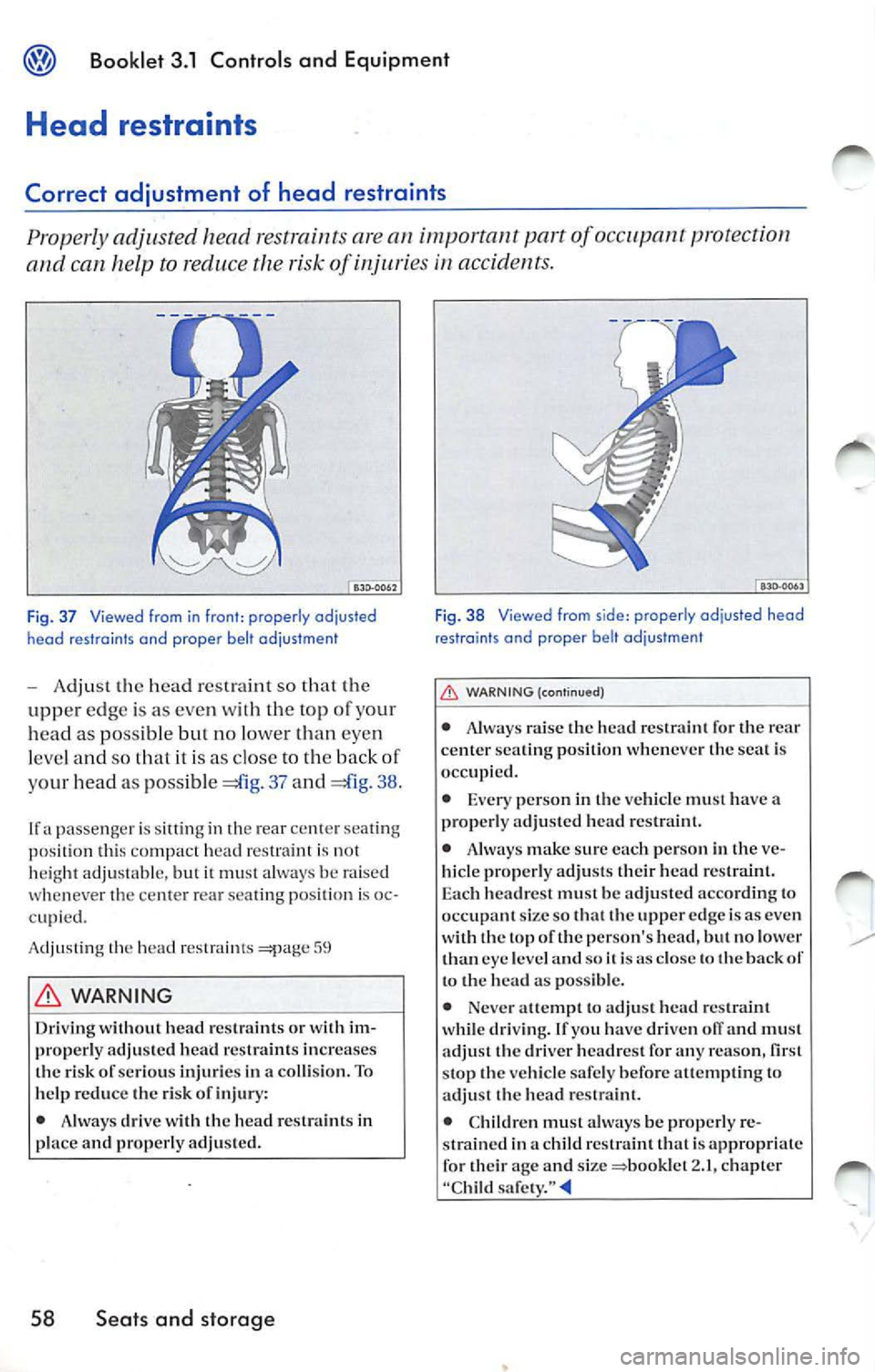
Booklet 3.1 Controls and Equipm ent
Head restraints
Correct adjustment of head restraints
Properly adjusted h ead restraints are an importa 11t part of occupant protection
and can help to reduce the risk of
in accidents.
Fig. 3 7 Viewed from in front : properly odjusted
heod restraints end proper belt odjustment
- Adjust the head restraint so that the
uppe r edg e is as eve n wit h th e top o f your
head as possible
no lo wer than eyen
l eve l and so th at it is as close to th e bac k of
y our head a s possi ble
37 and 38.
If a passenger is s itting in th e rear center sea tin g
position thi s co mpact h ead r estraint is no t
h eight adju stabl e, but it must always be raised
whenever the ce nte r rear sea ting posi tion is oc
c upi ed.
A dju sting the head
WARNING
Driving without head rest raints o r wit h im
prop erly adjusted head restraints inc reases
th e risk of serious injurie s in a co llision. To
h elp reduc e th e risk of injury:
• Always drive with th e head restraints in
place a nd properly adjuste d.
58 Seats and storage
F ig . 38 Viewed from s ide: properly adjusted head
restraints and proper belt ad justment
WARNING (contin ued)
• Always raise the head restrai nt for the r ear
center seating position wheneve r the seat is
occupied.
• Ever y perso n in th e ve hicle must have a
properl y adjuste d head r estra int.
• Alway s make sur e eac h person in the ve
hicle properly adju sts their head restraint.
E ac h headres t must be adjusted a ccord ing to
occupant size s o that the upper ed ge is as eve n
wit h the to p of the person's head, but no lower
tha n eye leve l an d soi
is as clo se th e back to the head as pos sibl e.
• Neve r attempt to adj ust head r estraint
wh ile dri vin g. If yo u have driven
and mu st
adjust the driver h eadrest for any reason,
stop the ve hicle safe ly befo re atte mptin g to
ad just the head r estra int.
• Children must always be properly re
s trained in a ch ild restrain t that i s appropr iate
for their age and size
2. 1, ch apter
"Chil d safety. "
Page 262 of 477
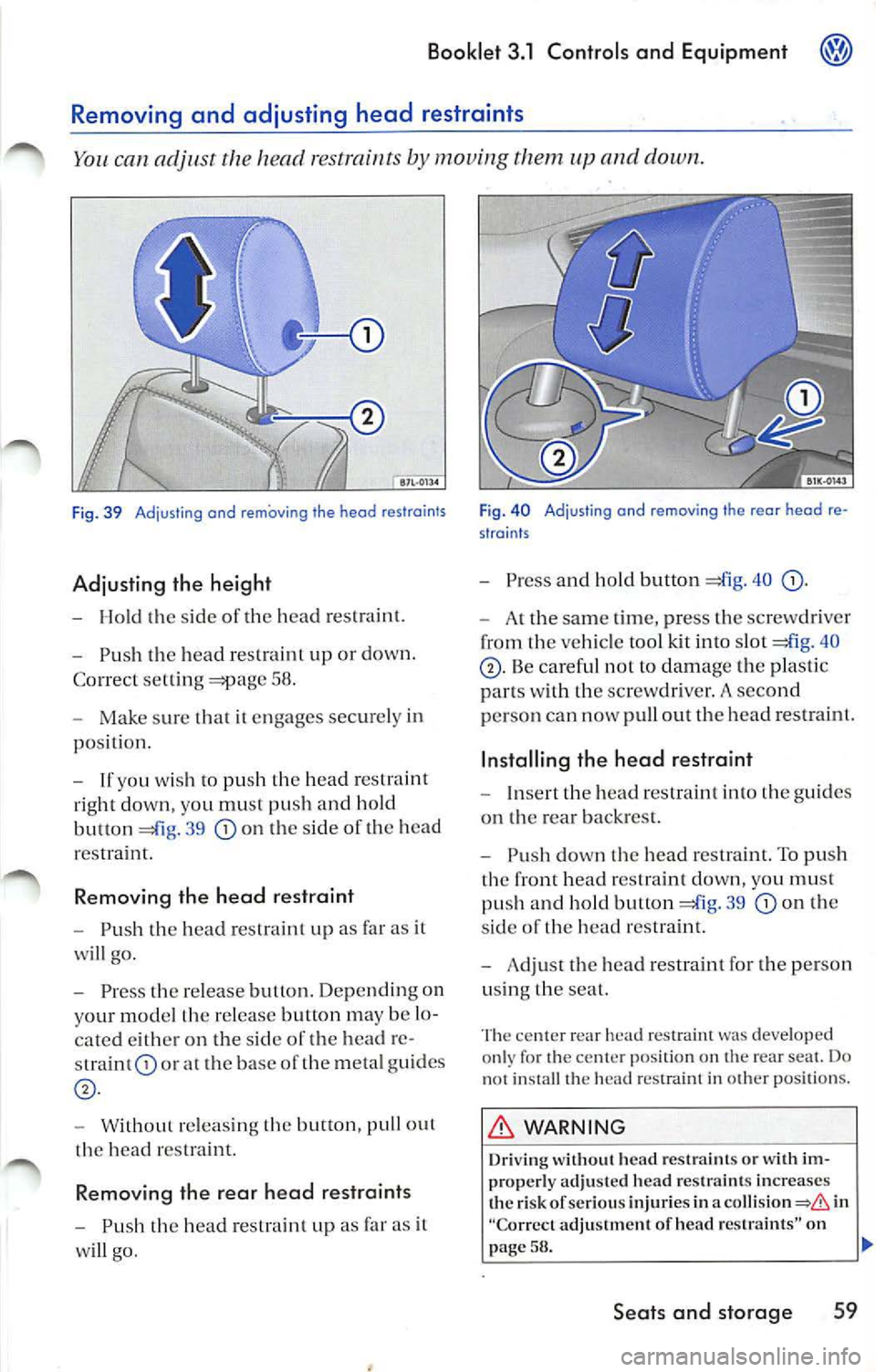
Booklet 3.1 Contro ls and Equipment
can adjust the head restraints by mouing them and down.
Fig. 39 Adjusting and removing the head restraints
Adjusting the height
- Hold the sid e o f the head restraint.
- Push the head res traint up or down.
C orr ect setting
58 .
- Make sur e that it en gages securely in
position.
- If yo u wish to push the head restraint
r ight down, you must push and hold
button =£lg.
39 on the side of the head
r e straint.
R em oving the head restraint
-Push the head restraint up as far as it
will go.
- Press the re lea se button . Depending o n
yo ur mod el th e re lease button may be lo
cated either on the sid e of the head re
straint
or the base of the meta l gu ides
- With out releasing the button, pull ou t
the head restra int.
Removing the rear head restraints
-Push the head re straint up as far as it
will go .
Fig. 40 Adjusting and removing the rear head re
straints
- Press and hold bu tton =£lg. 40
- A t the sam e time, press the screwdrive r
from the ve hicl e tool kit i nto slot =£l g. 40
pu ll out the head res traint.
Installing th e head re straint
- In se rt the head rest raint into the gu ides
on the rear backr est.
- Push down the hea d restraint. To push
the fro nt head re straint down, you must
pus h and hold butto n
39 on th e
s ide of the head rest raint.
- Ad just the hea d re straint for the person
u sing th e seat.
cen te r r ear h ead restraint was developed
on ly for the center position on the rear seat. Do
n ot install th e hea d res traint in oth er pos ition s.
WARNING
Driving w ithout h ead restraint s or w ith im
properly adjusted head restra int s in crease s
th e risk of serio us injuri es in
a in
"C orr ect adju stm ent of head res trai nts" on
58.
Seats and storage 59